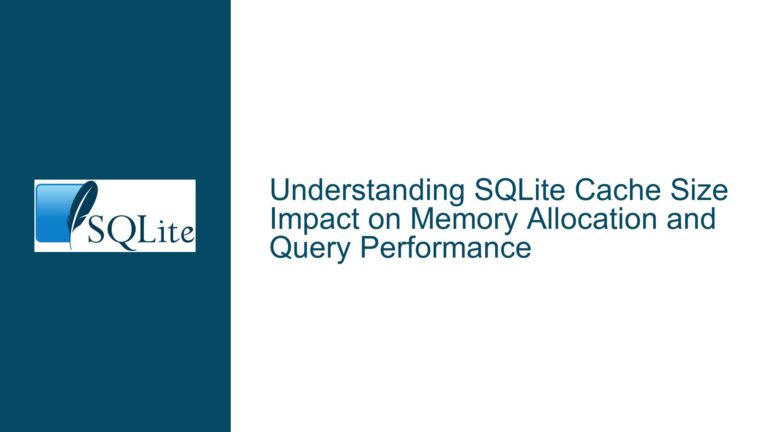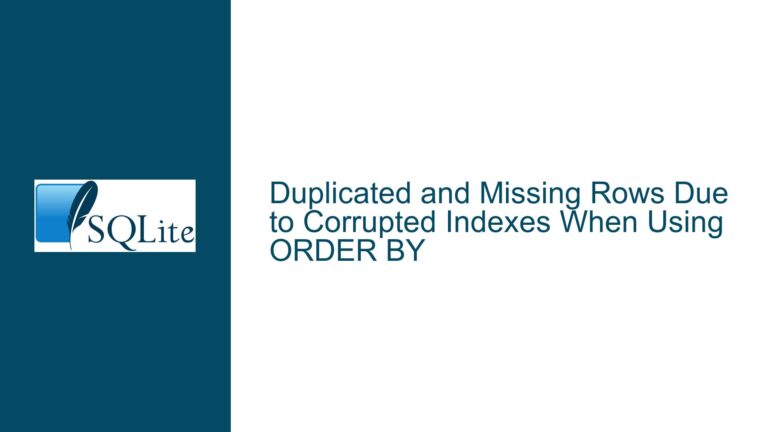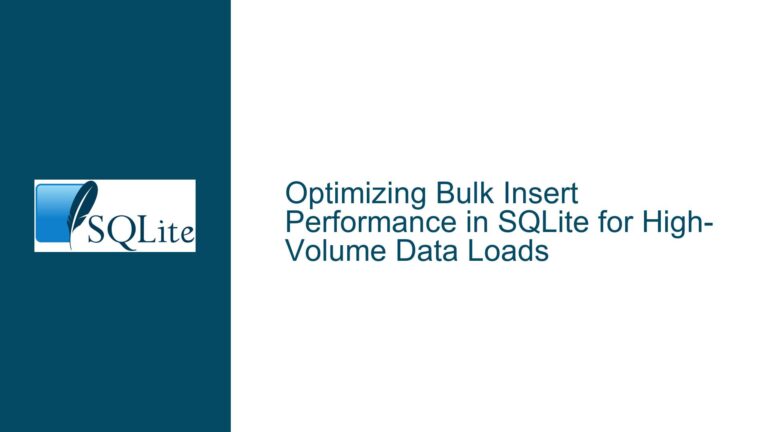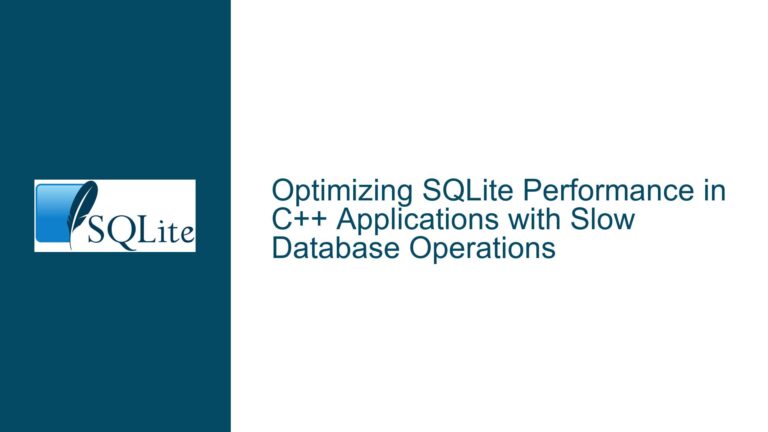Memory Growth During Repeated SQLite3 Prepared Statement Execution
Memory Accumulation Patterns in High-Frequency REPLACE/INSERT Operations
1. Operational Context and Symptom Manifestation
Nature of the Workload
The core issue involves an application executing frequent REPLACE or INSERT operations using SQLite’s C API (sqlite3_prepare_v2(), sqlite3_bind_*(), sqlite3_step(), sqlite3_finalize()). The application operates in a resource-constrained environment (OpenWRT on MIPS32) and exhibits progressive memory growth over time, as observed through tools like top, /proc/{pid}/status (VmRSS), or Xcode’s Instruments. The memory growth correlates directly with the execution of sqlite3_step(), particularly during write operations (REPLACE/INSERT), but stabilizes when using read operations (SELECT).
Key Observations
- Write-Intensive Operations: Memory growth is tied to
REPLACE/INSERTstatements. - Threading Model: Multithreaded execution via
pthread_detach(), with database handles potentially shared across threads. - Memory Measurement Discrepancy:
sqlite3_memory_used()reports stable values, while system-level metrics (VmRSS) show growth. - Caching Behavior: Memory stabilizes at ~8 MB in some test cases, suggesting internal cache thresholds.
Underlying Dynamics
SQLite manages memory through two primary layers:
- Application-Level Allocator: Tracks memory via
sqlite3_memory_used(), which accounts for explicit allocations (e.g., prepared statements, string buffers). - Internal Caches: Includes the page cache, lookaside memory, and temporary storage for write-ahead logging (WAL). These are not reflected in
sqlite3_memory_used()but contribute to process memory (VmRSS).
When executing write operations, SQLite may allocate memory for:
- B-Tree Modifications: Page splits during
INSERT/REPLACErequire temporary buffers. - Journaling/WAL: Transaction logs reserve memory or disk space depending on journal mode.
- Statement-Specific State: Prepared statements retain execution context until reset or finalized.
2. Root Causes of Memory Growth
A. Unmanaged Transaction Boundaries
Frequent REPLACE/INSERT operations without explicit transactions force SQLite to use autocommit mode, where each statement is treated as a separate transaction. This incurs overhead from repeated journal flushes and page cache adjustments. Autocommit mode exacerbates memory usage because:
- The page cache is not efficiently reused between transactions.
- Write-Ahead Logging (WAL): In WAL mode, checkpoints and log file management consume memory that may not be promptly released.
B. Prepared Statement Lifecycle Mismanagement
While the provided code calls sqlite3_finalize() after each execution, multithreaded usage introduces risks:
- Thread-Local Caches: SQLite’s lookaside memory allocator is per-connection. Concurrent access from multiple threads may fragment these pools.
- Statement Reset Omission: Failing to call
sqlite3_reset()before reusing a prepared statement can leave residual memory from prior executions (e.g., cached column values).
C. SQLite Configuration Limits and Cache Sizing
Default settings for SQLite’s memory subsystems may not suit high-frequency write workloads:
- Page Cache Size (
PRAGMA cache_size): A higher cache size retains more database pages in memory, improving performance but increasing baseline memory usage. - Lookaside Memory: Per-connection lookaside buffers (default 1200 bytes per slot) can accumulate in multithreaded environments.
D. Threading Model Contention
SQLite connections and their child objects (statements, B-tree cursors) are not thread-safe by default. While the serialized threading mode prevents data races, concurrent access to the same connection from multiple threads can cause:
- Contention for Internal Locks: Threads may block on
sqlite3_step(), causing OS-level memory allocation for suspended stacks. - Fragmented Lookaside Pools: Each thread may trigger independent lookaside allocations, leading to process-level memory bloat.
E. String Binding Modes and Lifetimes
Using SQLITE_STATIC with sqlite3_bind_text() assumes the bound string remains valid until the next sqlite3_step() or sqlite3_reset(). If the application invalidates the string prematurely (e.g., reusing buffers), SQLite may allocate internal copies, increasing memory usage.
3. Mitigation Strategies and Best Practices
A. Transaction Batching for Write Operations
Wrap multiple REPLACE/INSERT operations in explicit transactions to amortize overhead:
sqlite3_exec(db, "BEGIN;", 0, 0, 0);
for (int i = 0; i < N; i++) {
insert_data(...); // Uses sqlite3_step()
}
sqlite3_exec(db, "COMMIT;", 0, 0, 0);
- Effect: Reduces journal flush frequency and allows page cache reuse.
- Monitoring: Use
PRAGMA schema.journal_modeto verify WAL configuration.
B. Thread-Local Database Connections
Assign a dedicated sqlite3* connection to each thread to avoid contention:
void* thread_func(void* arg) {
sqlite3* local_db;
sqlite3_open(":memory:", &local_db);
// Use local_db for all operations in this thread
sqlite3_close(local_db);
return NULL;
}
- Advantage: Eliminates cross-thread synchronization overhead.
- Caveat: Use
PRAGMA temp_store=MEMORYif threads require temporary tables.
C. Prepared Statement Reuse and Reset
Retain and reuse prepared statements across invocations:
sqlite3_stmt* stmt_insert; // Global or thread-local
void prepare_once() {
sqlite3_prepare_v2(db, "REPLACE ...", -1, &stmt_insert, NULL);
}
void insert_data(...) {
sqlite3_reset(stmt_insert); // Reset before rebinding
sqlite3_bind_int(stmt_insert, ...);
sqlite3_step(stmt_insert);
// Omit sqlite3_finalize() to reuse the statement
}
- Critical Step: Call
sqlite3_reset()aftersqlite3_step()to reclaim execution state memory. - Cleanup: Finalize statements at application shutdown.
D. Configuration Tuning for Memory Subsystems
Adjust SQLite’s memory limits to cap baseline usage:
sqlite3_db_config(db, SQLITE_DBCONFIG_LOOKASIDE, NULL, 0, 0); // Disable lookaside
PRAGMA cache_size = 100; // Limit page cache to 100 pages
PRAGMA temp_store = FILE; // Use disk for temporary data
- Trade-off: Lower cache sizes may increase I/O operations.
E. String Binding and Lifetime Management
Ensure bound strings remain valid for the duration of sqlite3_step():
- Use
SQLITE_TRANSIENTif the string buffer is reused or stack-allocated:sqlite3_bind_text(stmt_insert, 3, tag, -1, SQLITE_TRANSIENT);This forces SQLite to create an internal copy of the string.
F. Memory Profiling and Leak Detection
Use platform-specific tools to isolate leaks:
- Valgrind (Linux): Rebuild SQLite with
-DSQLITE_MEMDEBUGto enhance leak detection. - Instruments (macOS): Profile the
Allocationsinstrument, filtering tosqlite3functions. - OpenWRT-Specific: Use
mallinfo()ormalloc_trim()to monitor heap usage.
G. Connection Pooling and Concurrency Models
For multithreaded applications, employ a connection pool with a fixed number of threads:
pthread_mutex_t db_pool_mutex = PTHREAD_MUTEX_INITIALIZER;
sqlite3* db_pool[POOL_SIZE];
sqlite3* acquire_db() {
pthread_mutex_lock(&db_pool_mutex);
// Return the next available connection
pthread_mutex_unlock(&db_pool_mutex);
}
- Benefit: Limits concurrent connections and associated memory.
H. File-Based vs. In-Memory Databases
If using an in-memory database (:memory:), switch to a file-backed database to leverage SQLite’s page cache eviction policies.
I. SQLite Version-Specific Behavior
Upgrade to SQLite ≥3.32.0 (2020-05-22), which introduced improvements to memory reclamation in write-heavy workloads.
Final Note: Progressive memory growth in SQLite is often attributable to configuration mismatches rather than leaks. By aligning transaction boundaries, threading models, and cache settings with workload requirements, most "leak-like" behaviors can be resolved. Always validate memory claims using both SQLite’s internal counters (sqlite3_memory_used()) and system-level metrics to distinguish genuine leaks from cache expansion.






